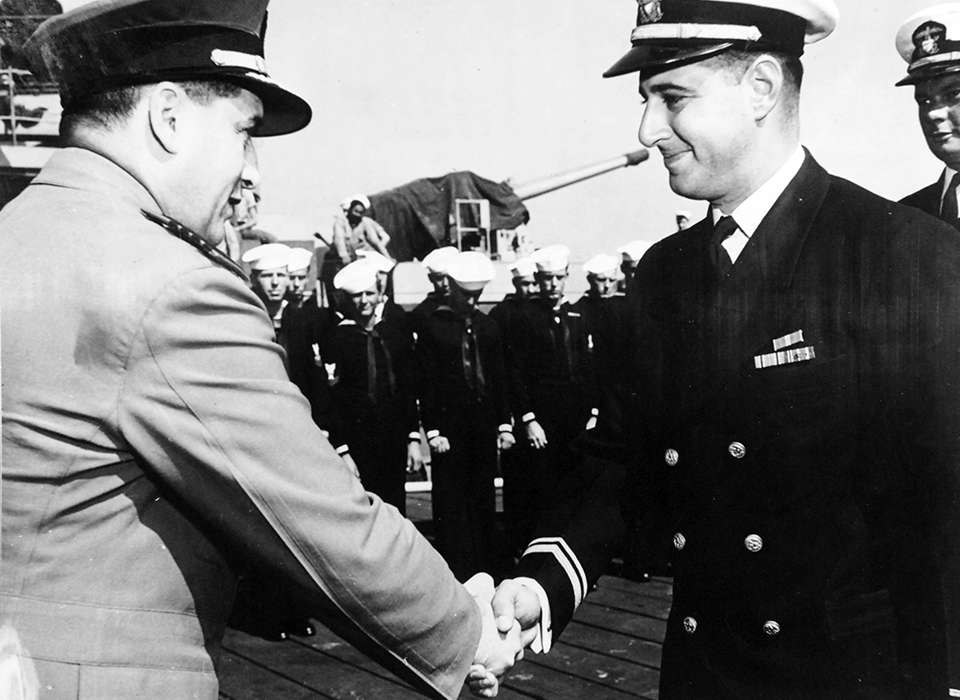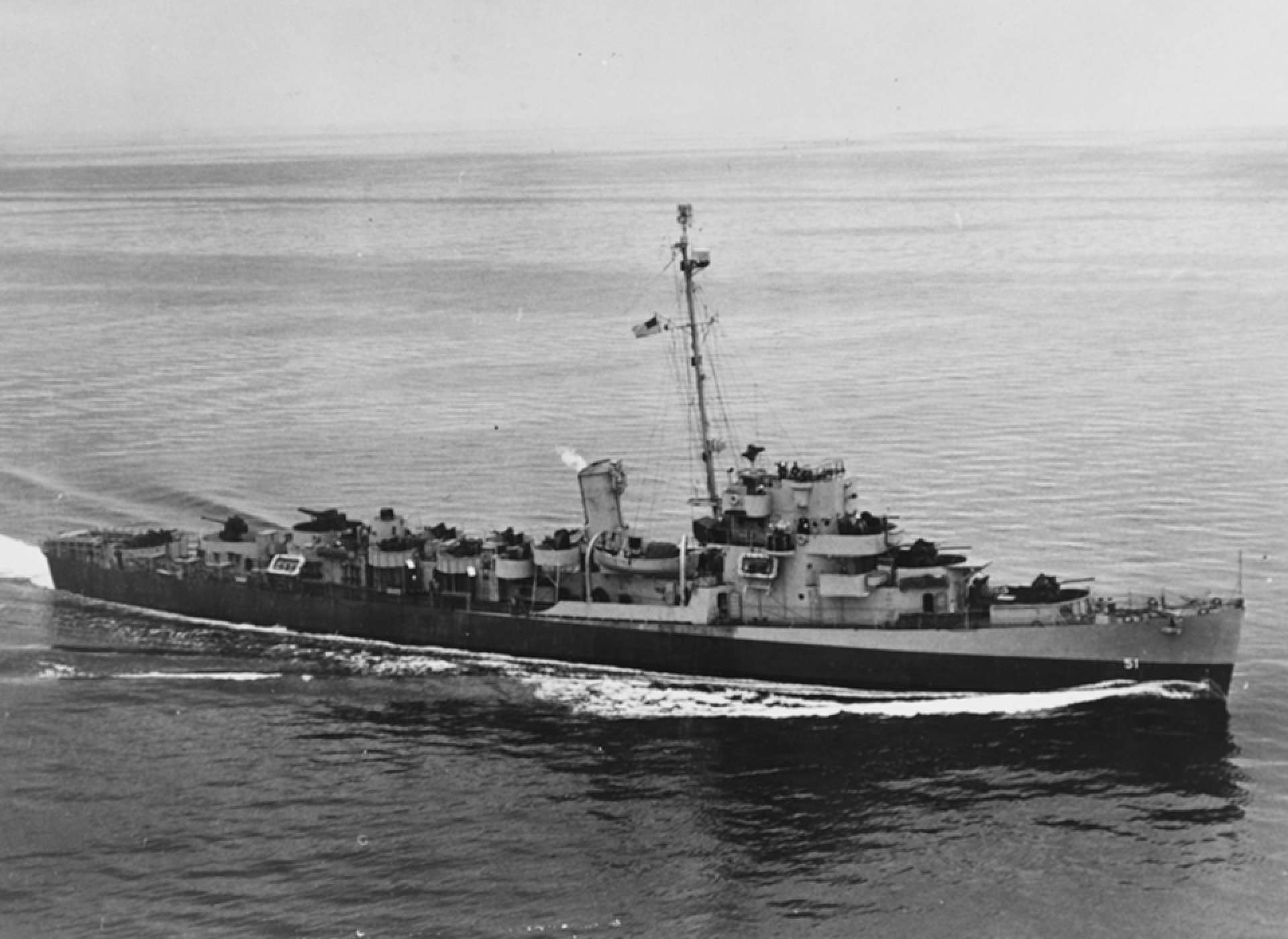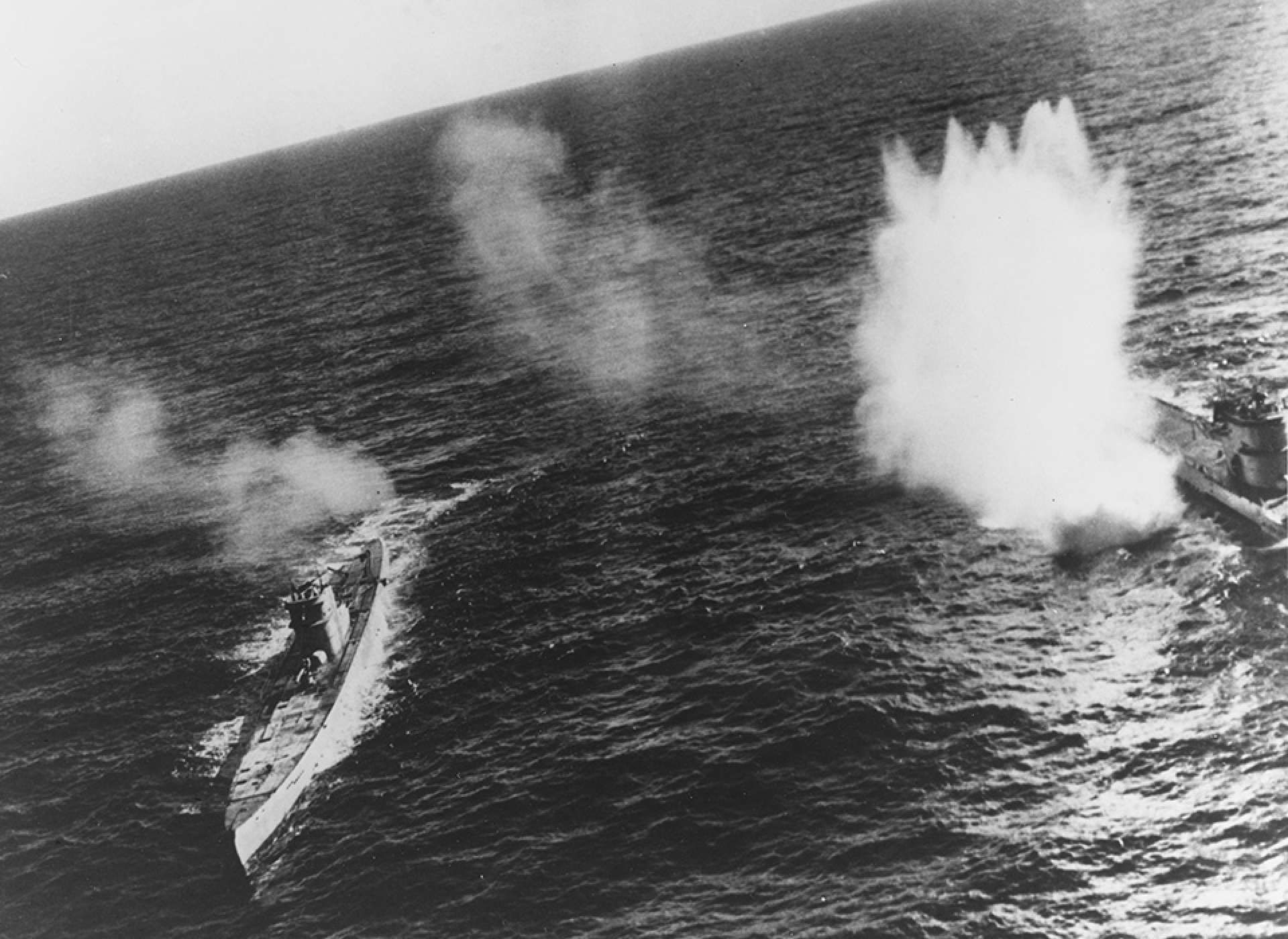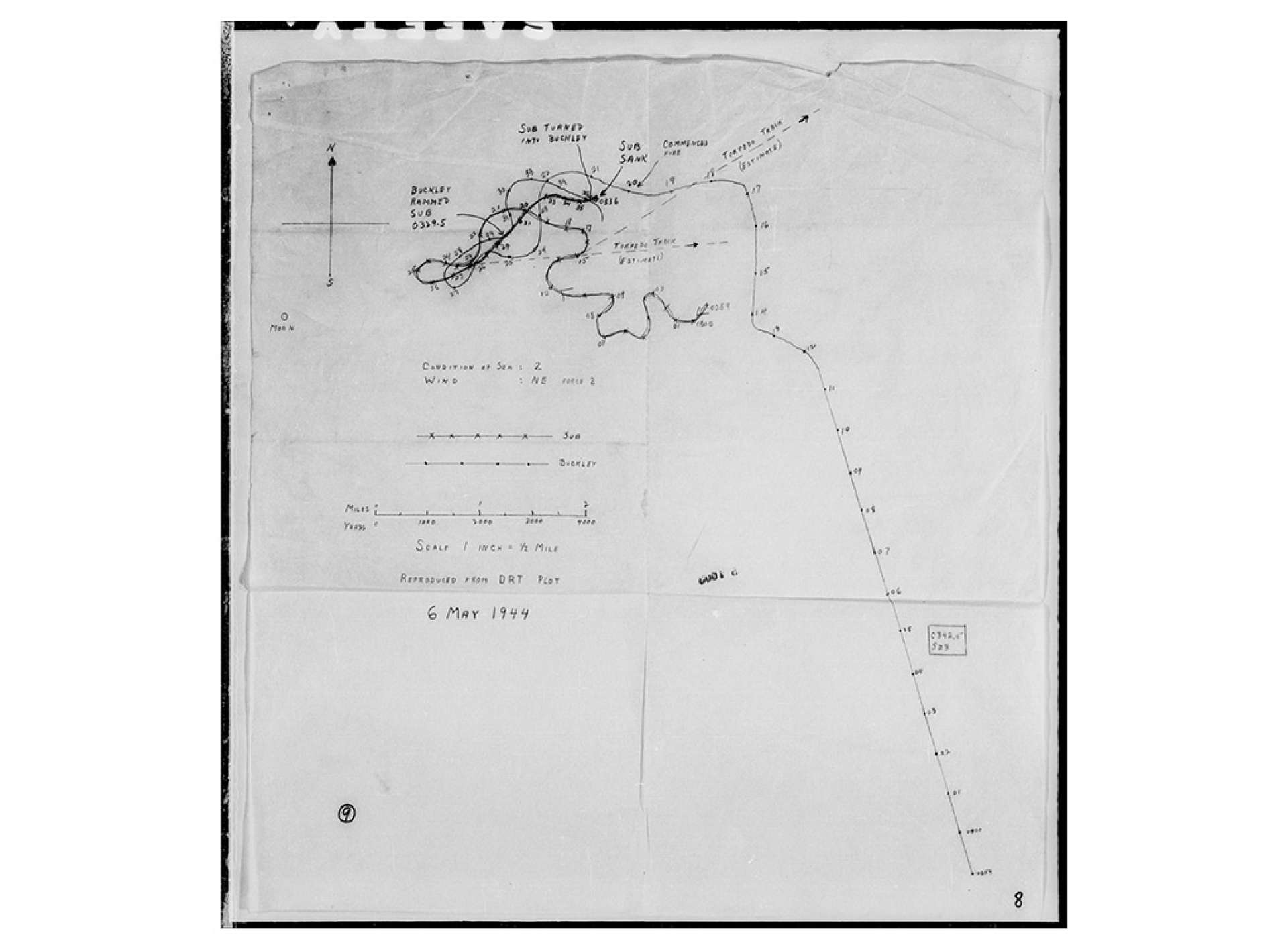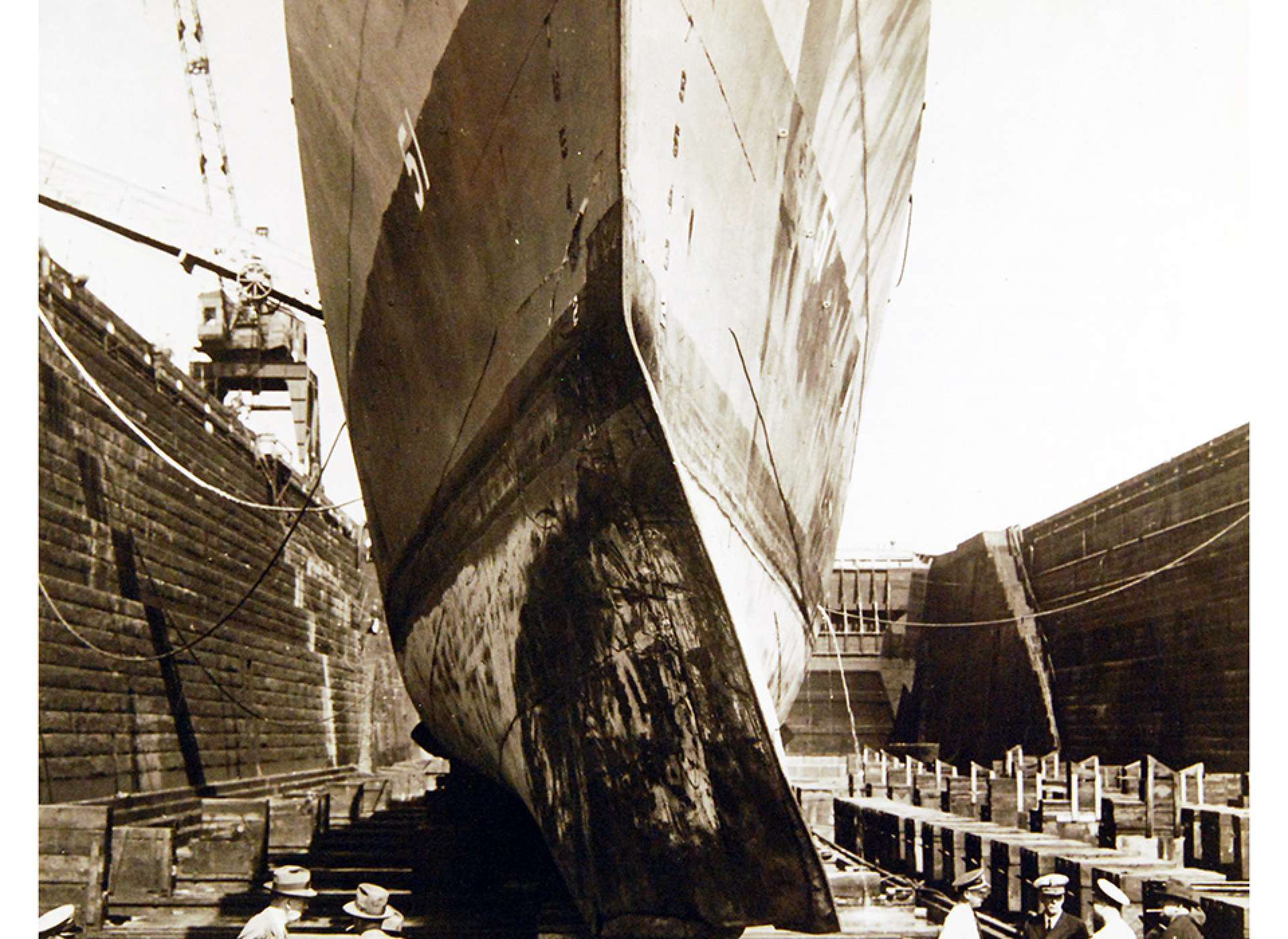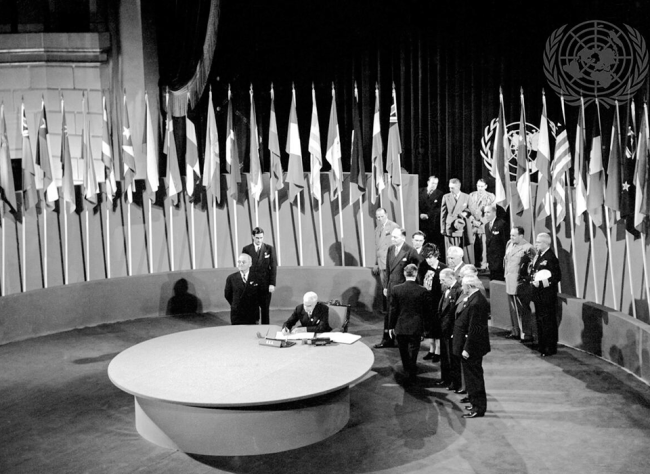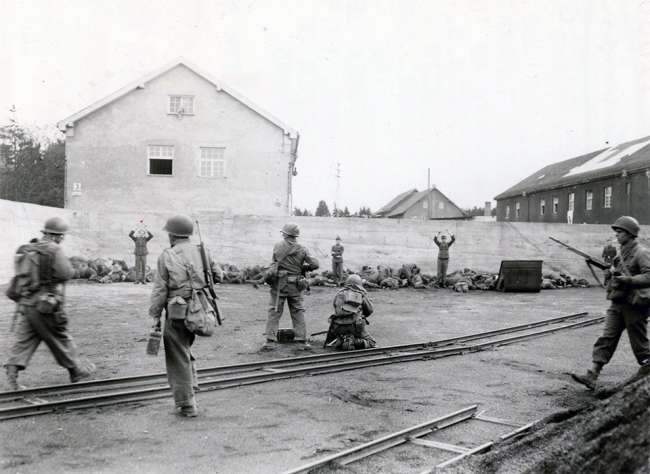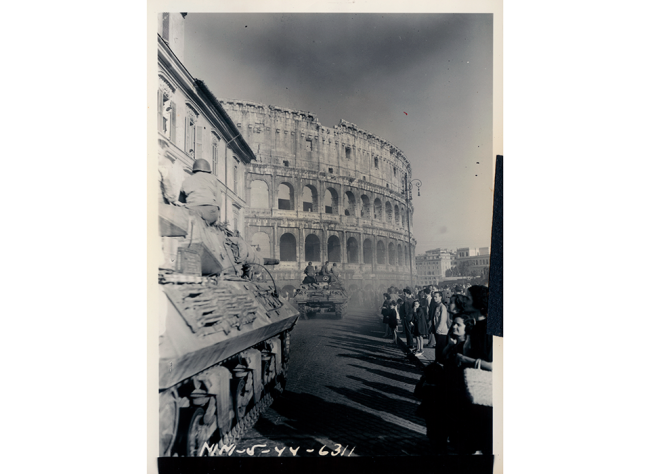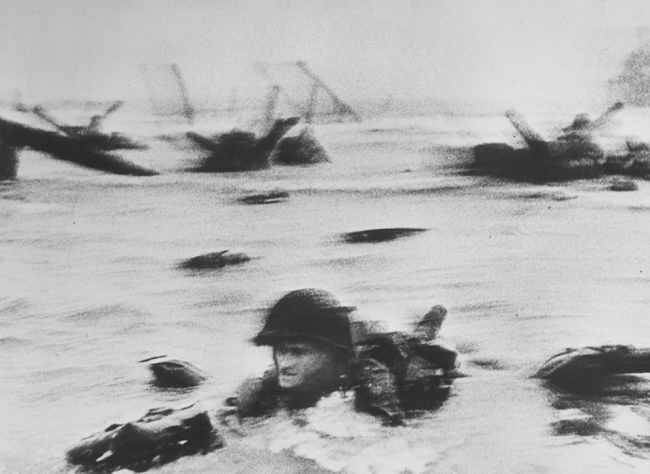The Battle of the Atlantic has the distinction of being the longest continuous battle of World War II. It began on September 3, 1939, when U-30 sank the passenger ship SS Athenia with the loss of 112 civilian lives. With this opening strike, submarines of the German Kriegsmarine roved the Atlantic Ocean with near impunity until the Allies turned the tide in 1943. Coined the Battle of the Atlantic by British Prime Minister Winston Churchill in the early part of 1941, the prolonged battle was filled with innumerable engagements between Allied naval and air forces and the determined and effective German U-boat crews. One of these many engagements was a duel between the American destroyer escort (DE) USS Buckley (DE-51) and U-66.
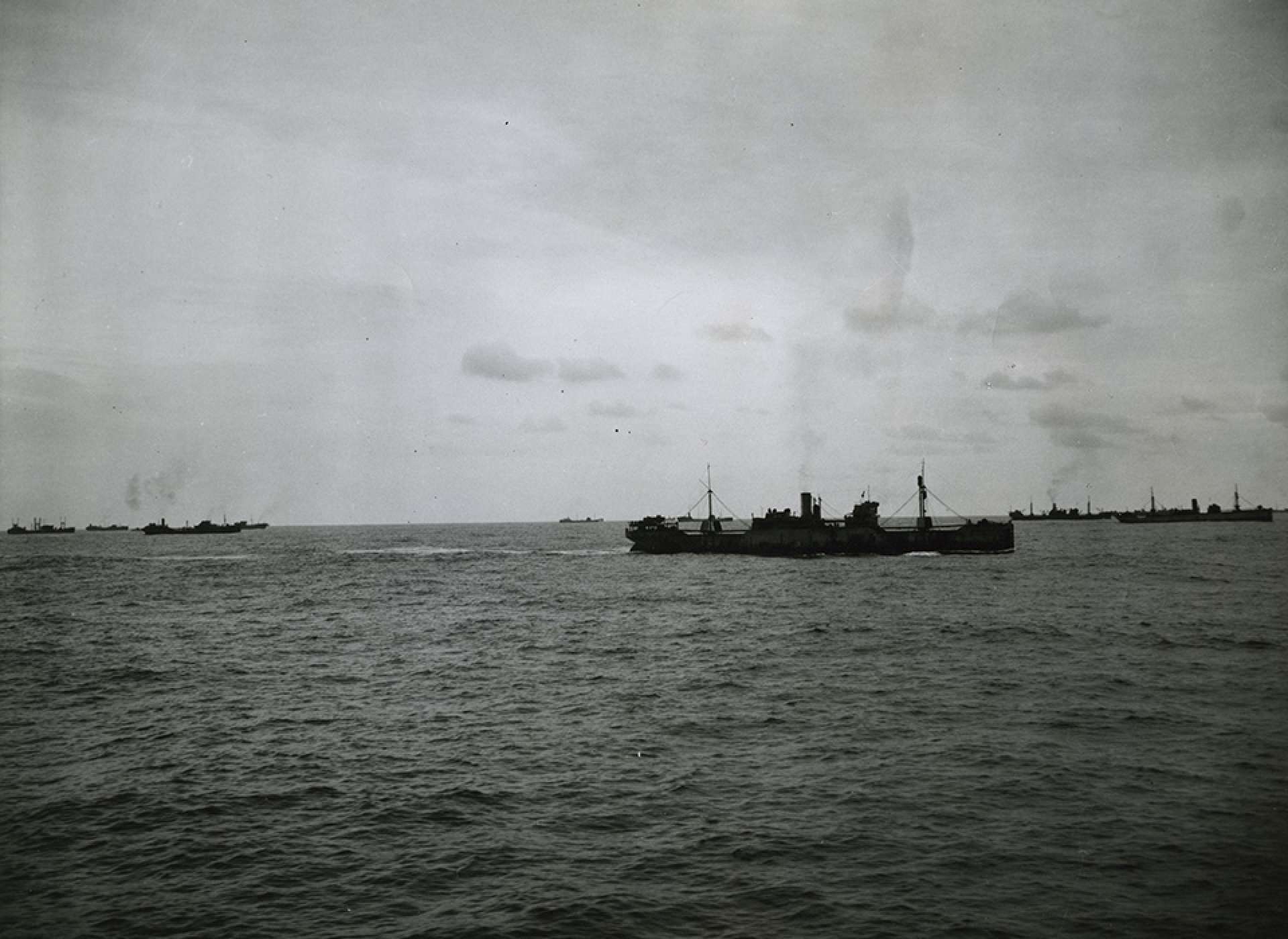
An Atlantic convoy making the slow trek across the Atlantic. The slow ships were easy pickings for formidable “Wolf Packs” of German U-boats. The National WWII Museum, Gift of Mary Noble, 2010.130.063.
In 1943, the tide had begun to turn in favor of the Allies in the Battle of the Atlantic. The development of new technologies and tactics gave the Allies the upper hand in the fight against German U-boats. One key to this success was the creation of escort carrier groups, also known as “hunter killer” groups. No longer bound to sail with a convoy, these groups were free to pursue quarry all the way to to Davy Jones’s Locker. In early May 1944, Buckley was conducting operations as part of Task Group 21.11 off the Cape Verde Islands when her crew received a report of disappearing radar contact and was sent to investigate. What followed was akin to a bar room brawl on the high seas.
According to the Action Report, the night of May 5-6 was beautiful, calm, and moonlit. The conditions were perfect for U-boats to refuel and replenish desperately needed supplies at sea, and for a hunter killer group to seek out U-boats low on fuel and crewed by men near their breaking point. Submarine duty was dangerous, and crews were often deployed past exhaustion. U-66, commanded by Oberleutnant zur See Gerhard Seehausen, was on her ninth patrol, and had been at sea since mid-January. She was badly in need of fuel and provisions for her trip home when Buckley began to stalk her.
-

USS Buckley off Boston following repairs necessary after the engagement with U-66. Commissioned April 30, 1943, she was the lead ship in her class of destroy escorts. US Navy photograph courtesy of the US National Archives.
-

August 1943. On the left is U-66, the right is U-117. The two U-boats are being bombed by US Navy aircraft. U-66 escaped, U-117 was sunk. US Navy photograph, courtesy of Naval History and Heritage Command.
At 0216 (2:16 a.m.), a “night owl” Avenger picked up a radar contact 20 miles from Buckley and reported it to the ship. Her commanding officer, Lieutenant Commander Brent Abel, ordered flank speed and a course to the target. For 45 minutes Buckley sailed at full speed (23.5 knots) towards the U-boat, preparing to engage. The avenger, piloted by Lieutenant (junior grade) Jimmie J. Sellars, stayed on course, following the U-boat and relaying course changes to Buckley, coaching the little destroyer escort to the spot. Below Sellers, U-66 was slowly proceeding on the surface, charging her batteries and searching for the supply U-boat. Unbeknownst to Seehausen, the Avenger carried no weapons, but the seasoned skipper knew the aircraft would wait for him to submerge before attacking.
Buckley, closing within seven miles, made radar contact with U-66 at 0246. Lt. Commander Abel called the ship’s crew to General Quarters and streamed a Foxer, an acoustic decoy used to confuse the acoustic torpedoes then in use by U-boats. Holding fire, Abel took a risk and began to close in on the submarine, hoping that the boat’s crew would confuse her with the supply boat they sought. The gamble paid off, and at 0308, U-66 fired off three red flares, believed to be a recognition signal. Buckley continued on course, steadily closing in on the U-boat, but not revealing her identity. Less than 10 minutes later, the two vessels were at a range of 4,000 yards. U-66, realizing that the vessel headed toward her wasn’t the milch cow (supply boat) she was looking for, put a fish in the water.
Buckley made a turn left, putting the U-boat dead ahead. Only then did some of the crew topside notice the torpedo wake passing down the starboard side of the ship. Abel altered the ship’s course to put the sub in the moon and to expose the Foxer to any additional torpedoes. All guns aboard Buckley were loaded as the turn put them within firing range of the submarine. The moment was coming, the two vessels closing in, each crew waiting for the other to open fire.
The German sailors were the first on the trigger, opening fire with machine guns. At 0320, Abel gave the order to commence firing. The opening salvo from the DE’s three-inch guns scored a direct hit on the submarine’s forecastle, just forward of the conning tower. All guns that could bear on the sub opened up—20mm Oerlikons, 40mm Bofors, and the three-inch batteries. For two minutes the DE rained down steel on the U-boat, exchanging fire, though the sub’s aim was high, mostly missing its mark. Abel called ceasefire as the sub turned away, giving his ship a moment to adjust course. Within a minute he called again for fire at a range of 1,500 yards. The gun crews aboard Buckley found their mark, hitting the U-boat rapidly and accurately. Shells could be seen hitting the submarine’s conning tower and bursting.
U-66 ceased returning fire and began to maneuver erratically, trying to put distance between herself and Buckley in order to fire off another torpedo from her stern tubes. The wake gave the torpedo away, as Abel ordered the ship to take a hard right, narrowly missing the lethal projectile as it crossed Buckley’s bow. The two ships began a dance. The conning tower of U-66 began to burn as the boat started evasive maneuvers, but the agile DE was hot on her tail, turning to and fro with her target. The range between the ships grew closer as the gun crews aboard Buckley buried the submarine under withering point-blank fire. One thousand yards, 500 yards—within mere minutes the two adversaries were a scant 20 yards apart on a parallel course, the U-boat getting raked with fire from stem to stern. On the air, Sellers was radioing a play-by-play to the lead ship in the task group, reporting: “Buckley has opened fire—sub is returning fire. Boy! I have never before seen such concentration! Buckley is cutting hell out of the conning tower!”
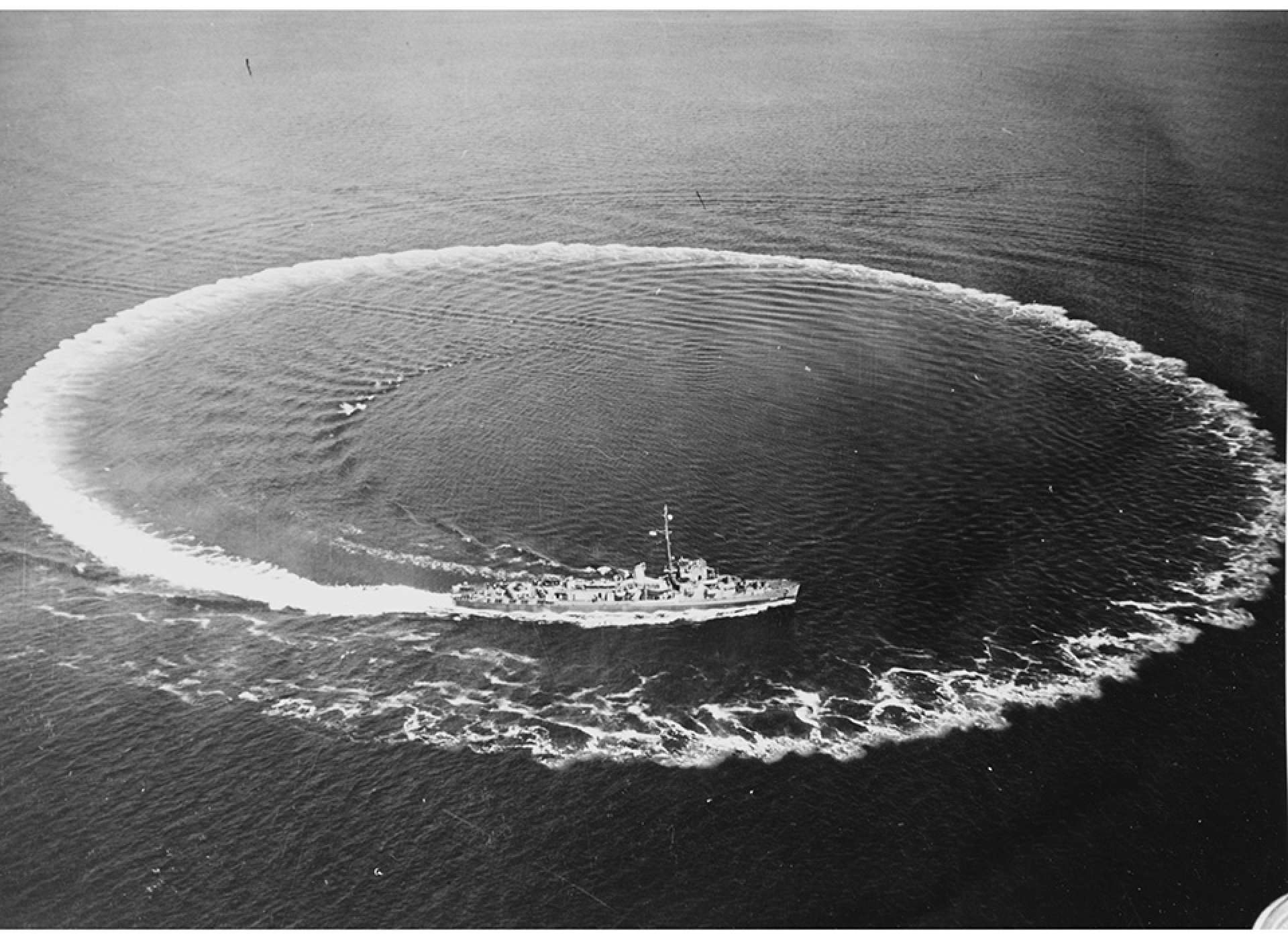
The agility of destroyer escorts is shown here as Buckley makes a full turn at 20 knots during her speed trials in 1943. The diameter of the circle is estimated to be 1,000 feet. US Navy photograph, courtesy of Naval History and Heritage Command.
At 0329 Lt. Commander Abel made an audacious decision, ordering hard right rudder, putting Buckley in position to ram U-66. The DE turned sharply toward the U-boat as the boat’s captain gave the abandon ship order. Buckley’s bow crashed across the forward deck of the U-boat, locking the two together. German sailors began to pour out of the burning boat, some brandishing weapons, while others put their hands up in surrender. In the heat of the moment, chaos ensued as hand-to-hand combat broke out.
Sailors aboard Buckley opened up with small arms fire. A boatswain’s mate shot one German sailor with his .45 caliber pistol, while another sailor suffered Buckley’s only casualty when he bruised his fist knocking an opponent off the ship. Buckley’s crew grabbed what they could and joined the fray. One three-inch gun crew picked up empty shell casings and threw them at the boarding Germans. Two of the most unique weapons were kitchenware.
Several sailors employed coffee mugs in the fight, while a steward’s mate expelled one German sailor from the wardroom with a coffee pot.
The man to man fight lasted only a minute as Buckley backed off the U-boat, separating the two. Five Germans clustered on the bow surrendered, and were marched below by a gunner’s mate armed with a hammer.
The remaining crew aboard U-66 were still piloting the boat and began a maneuver that appeared to be an escape. Ringing for flank speed, Abel was not going to let the U-boat slip away. As crewmen aboard Buckley prepared to drop depth charges, U-66 lunged, turning on a collision course. It was likely out of control, but it was bearing down. At 0335, it struck Buckley. It was a glancing blow but tore open a hole in the after engine room, sheared off the starboard propeller shaft, and twisted the ship’s stern. As she passed, crewmen topside on Buckley could see into her conning tower, and one sailor, tossed a hand grenade into a hatch. The U-boat cleared the DE but was now engulfed in flames and wildly out of control. As the rest of the German sailors abandoned ship, U-66 began to sink, her captain still aboard. Buckley’s Action Report detailed the U-boat’s sinking: “Sub clears and passes astern, still making about 15 knots. No. 3 3” gun scores 3 direct hits on conning tower. Sub disappears under surface of water at this speed under diesel power with conning tower hatch open and fire blasting from it, apparently completely abandoned and out of control. Forward deck hatch also open. Entire action has lasted 16 minutes.”
-

This map, taken from the Action Report filed by Buckley’s commanding officer, Lt. Commander Abel, tracks the engagement his ship with U-66. US National Archives via Fold3.com.
-

In drydock in Boston, the damage to Buckley’s bow is evident. Ramming the U-boat to the starboard side pushed the bow over to port and collapsed a few internal compartments. US Navy photograph, courtesy of Naval History and Heritage Command.
The enemy gone, Buckley stayed in the area for the next three hours, plucking survivors out of the sea. Thirty-six of the U-boat’s crew were saved, more than half of her complement. Most were wounded, with shrapnel wounds or worse. Along with the damage to her stern, Buckley’s bow was bent to port from ramming U-66 and she had a few holes from the U-boat’s guns. In the 16 minute engagement with U-66, she had expended 105 rounds of three-inch shells, 2,700 rounds of 20 mm ammunition, and 418 rounds of 40 mm shells. Small arms fire, which included .45 and .30 caliber, as well as shotgun buckshot, totaled 390 rounds.
For the daring action of her crew in sinking U-66, Buckley was awarded the Navy Unit Commendation. Her Commanding Officer, Lieutenant Commander Brent Abel, was awarded the Navy Cross “for extraordinary heroism and distinguished service in the line of his profession as Commanding Officer of the Destroyer Escort USS Buckley.” The crew sailed Buckley back to the United States under her own power, where she underwent repairs in Boston before returning to duty in the Atlantic. The Battle of the Atlantic ended after the German surrender a year later in May 1945. In this nearly six year battle, 781 U-boats were sunk by Allied forces, with the loss of German sailors estimated between 28,000 - 32,000. Allied losses were staggering, with over 2,700 merchant ships lost and more than 130,000 Allied sailors lost.
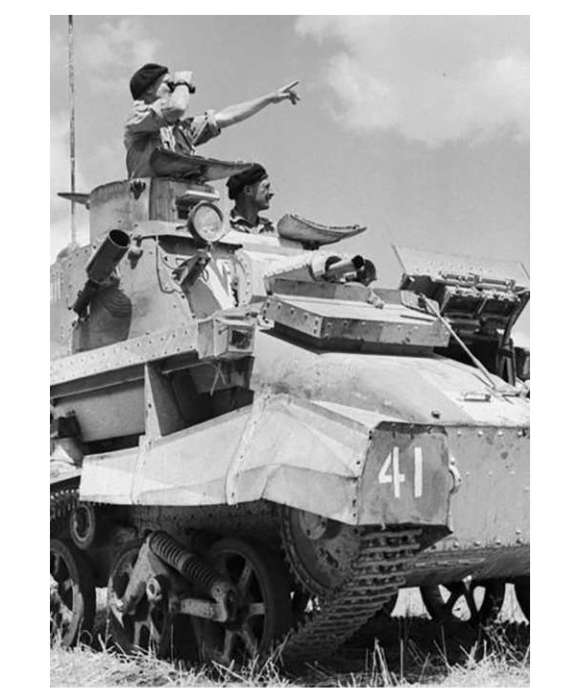
Forgotten Fights: The Battle of Deir ez-Zor, July 1941
Syria became a battleground in July 1941, when British forces launched an invasion to secure their hold on the Middle East. General "Bill" Slim's strike at Deir-ez-Zor was a critical victory.
Kali Martin
Cite this article:
MLA Citation:
APA Citation:
Chicago Style Citation:
